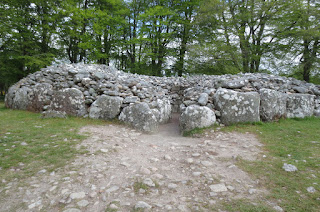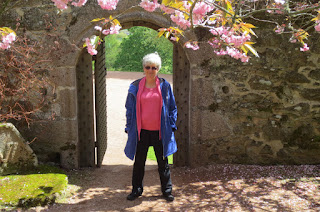
Ann R. said haggis and black pudding were two of her favorites, and I challenged myself to try them. The haggis I ate tonight at World's End was like loose sausage. If someone put a gun to my head, I'd eat it again. Can't say the same for black pudding, which I ate in the Isle of Lewis several days ago. It was crispy and crunchy on the outside and slippery and slithery on the inside. Like sky-diving, once was enough.
Our waiter told us that haggis stops at the border. The English won't eat it. He also confirmed that this pub and restaurant was the one referred to in one of the Outlander books, but those events happened going on 300 years ago. And they were fictional.
The Hidden Door in Edinburgh involves experimental artists who find empty spaces in the city and transform them--old warehouses, in this case. My favorite piece was a small trailer with twigs growing out of the walls and furniture, and short, plaintive verses printed on the walls and ceiling. Other works were tires painted pink, a male mannequin with an alligator head, a typewriter covered with plaid and polka dots,

and a floor littered with rocks. We think Ron Rainville would like the rocks because he so enjoyed the pile of bird-mats at the Mattress Factory in Pittsburgh.
I don't know what the message was in this unusual art, but I appreciate any evidence of imagination, bewildering though it may be.
Edinburgh was bursting with sunshine and life today. The sidewalks were crammed, and sunbathers found spots in front of the National Gallery of Scotland (see photo below).
We found Cleopatra in the National Gallery with an asp ready to bite her nipple. Couldn't it have just bit her big toe? Hasn't the poor woman gone through enough?
We fly home tomorrow. It's a lovely country, but we probably won't return. There are too many other places in the world to see, and time's a'wastin'.







































 I
I






